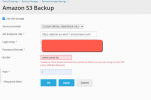Amazon glacier is the new backup solution, costing pennies a month opposed to hundreds.
http://aws.amazon.com/glacier/
Do summarise it quickly, it is the new, ultra cheap storage solution available.
Perfect for Plesk backups. However it requires API integration, not just an FTP connection.
Would be awesome if you guys could make this work.
http://aws.amazon.com/glacier/
Do summarise it quickly, it is the new, ultra cheap storage solution available.
Perfect for Plesk backups. However it requires API integration, not just an FTP connection.
Would be awesome if you guys could make this work.
We are excited to announce the immediate availability of Amazon Glacier – a secure, reliable and extremely low cost storage service designed for data archiving and backup. Amazon Glacier is designed for data that is infrequently accessed, yet still important to retain for future reference. Examples include digital media archives, financial and healthcare records, raw genomic sequence data, long-term database backups, and data that must be retained for regulatory compliance. With Amazon Glacier, customers can reliably and durably store large or small amounts of data for as little as $0.01/GB/month. As with all Amazon Web Services, you pay only for what you use, and there are no up-front expenses or long-term commitments.
Amazon Glacier is:
•Low cost- Amazon Glacier is an extremely low-cost, pay-as-you-go storage service that can cost as little as $0.01 per gigabyte per month, irrespective of how much data you store.
•Secure - Amazon Glacier supports secure transfer of your data over Secure Sockets Layer (SSL) and automatically stores data encrypted at rest using Advanced Encryption Standard (AES) 256, a secure symmetric-key encryption standard using 256-bit encryption keys.
•Durable- Amazon Glacier is designed to provide average annual durability of 99.999999999% for each item stored.
•Flexible –Amazon Glacier scales to meet your growing and often unpredictable storage requirements. There is no limit to the amount of data you can store in the service.
•Simple– Amazon Glacier allows you to offload the administrative burdens of operating and scaling archival storage to AWS, and makes long term data archiving especially simple. You no longer need to worry about capacity planning, hardware provisioning, data replication, hardware failure detection and repair, or time-consuming hardware migrations.
•Designed for use with other Amazon Web Services – You can use AWS Import/Export to accelerate moving large amounts of data into Amazon Glacier using portable storage devices for transport. In the coming months, Amazon Simple Storage Service (Amazon S3) plans to introduce an option that will allow you to seamlessly move data between Amazon S3 and Amazon Glacier using data lifecycle policies.
Amazon Glacier is currently available in the US-East (N. Virginia), US-West (N. California), US-West (Oregon), EU-West (Ireland), and Asia Pacific (Japan) Regions.
A few clicks in the AWS Management Console are all it takes to setup Amazon Glacier. You can learn more by visiting the Amazon Glacier detail page, reading Jeff Barr’s blog post, or joining our September 19th webinar.

